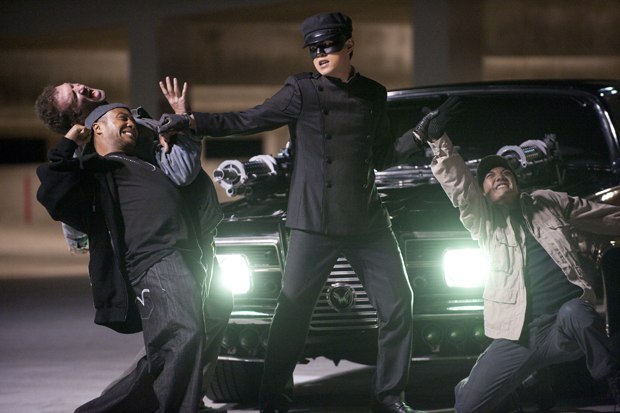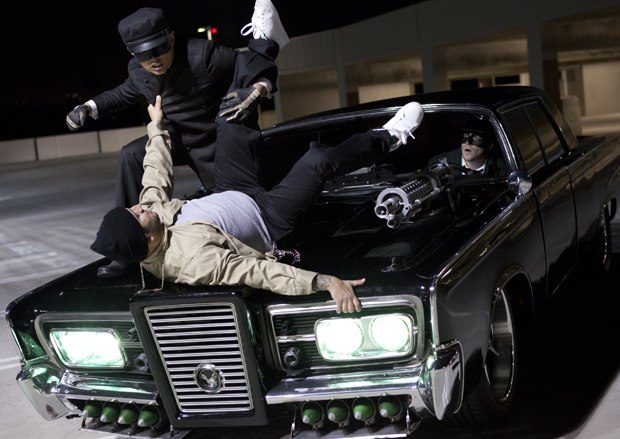Michel Gondry tells how he turned the DC comic into the ultimate mind-bender.
Check out the trailer for The Green Hornet at AWNtv!
It turns out that Michel Gondry (Eternal Sunshine of the Spotless Mind) was a natural for The Green Hornet, considering Seth Rogen's wacky vision and the director's penchant for brain teasers. Last night Gondry even applied his cerebral magic to Jimmy Kimmel Live! in a fun promotional stint (ABC. com) Gondry discusses some of his favorite moments from The Green Hornet, including Kato Speed and Kato Vision (more about the vfx challenges on Monday).
Bill Desowitz: I was curious to read that you were previously connected to The Green Hornet at Universal in '97.
Michel Gondry: That's true: one of the rare truths that's been written on the net.
BD: You obviously have a passion for this.
MG: I have a passion for it and felt personally connected to it -- it was supposed to be my first feature. I even let down my son, who was six at the time, and was very excited when I told him the story and had to tell him I wasn't going to do it. When I was asked again, I was like, "Yes, I want to show my son that I'm doing what I'm saying."
BD: What appealed to you about The Green Hornet?
MG: What I liked the best in the new version was the take of Seth and [co-writer] Evan [Goldberg], which was how you did with your sidekick [played by Jay Chou] when he's cooler than you. It was a terrific idea to develop.
BD: Didn't you also find it subversive: Seth being a slacker and the pretense that they're villains?
MG: Yes, and they both hate the father [played by Tom Wilkinson].
BD: What I found most interesting was how you incorporate your interest in manipulating time and space. What was it like visualizing Kato's fighting?
MG: Well, we took two stunt guys in New York and asked them to fight certain ways, knowing that we would change the speed of one of them and then in the same shot we would reverse the process. So, basically, let's say you have two characters shot in the same frame. There's a sort of bank of time or frames that is available, so when one speeds up, it involves time in the future. So now they are not in the same dimension, so it's OK as long as they don't interact physically with each other because it would be a pure special effect. But what happens is that if I want to get them back in the same time and space, the faster one has to become slower or the other one has to become faster. So I had to keep the time changing as much as I could while they're not physically interacting. So that was the beginning of the idea about playing with the space/time theory where you borrow time and reimburse it.
BD: How challenging was that technically?
MG: We had a lot of problems because the camera is moving only in one time, so if you change the time of one character then it isn't going to be part of the same landscape. So you have to track into the landscape to keep him part of the same background, but, in doing that, you start to stretch the entire world that you are shooting, so it becomes really interesting. So when I showed that to Seth and Evan and the studio, they really got excited about it and getting the job.
BD: How did you make Kato Speed work?
MG: We had to make it look exciting. Neal Moritz [the producer], who is very used to his movies going very fast and furious, was sometimes disconcerted, so he challenged me to make it exciting. So it was complicated for me to make it exciting during the shooting and then after in postproduction. I knew what I wanted but you don't want to take such a chance for a movie that is so expensive. But on the other hand, the studio didn't know why I was doing that and what it was for, but they let me do it because they didn't want to miss out on something.
BD: What about Kato Vision: the telescopic look for a more graphical depiction of what's going on around him?
MG: Yeah, I like how you describe it: You put it in better words than me.
BD: Well, I had a little help from CIS.
MG: Well, I wanted people to feel the impact and what it must've been like to discover slow motion for the first time when it was invented. So I thought: "OK, maybe multiplying the space when somebody hits somebody else would give this feeling." So I tried to find an effect to convey this kind of visceral emotion. It's not something that your senses tell if something is wrong. Remember the Smirnoff poster in LA where they had two pairs of eyes on a subject? It's very unsettling because when you see the double eyes it makes you want to drive off the road. I think our senses grab glimpses of the real world in a very messy order. And out of this mess we construct a reality that we feel we belong to in order to live through it. There is a huge element of reconstruction that your brain does constantly, and I think if you take those glimpses and mess about with that it becomes all about illusion and magic tricks. I always like to play with that and it becomes unsettling for the audience.
BD: What about impact of all of this on Kato?
MG: It's like when you're dozing while watching TV. You wake up and you feel like you're sleeping 20 minutes but you're still watching the same shot, so obviously you slept for five seconds. The fact that your brain expanded the shot so much I felt we could use that as the reason why Kato could take all the time he wanted to analyze the fight while it was happening. It's a self-hypnosis.
BD: Going outside of himself.
MG: Yeah, exactly.
BD: And what about Britt's wild recounting of the crime in flashback?
MG: Well, on set Seth had written a very funny sequence when he was talking to himself and trying to piece things together. And I thought I had to find something funny visually to solve this problem. And I wanted him to have a similar kind of experience with time and space as Kato. I couldn't find what it was until the very end of the shooting. Then it became clear to me when we were redoing the lighting for the flashbacks that they should each have a different perspective, and to show that I just changed the lighting and made it a little like Eternal Sunshine of a Spotless Mind. But this was not enough so I had this idea one weekend: What if in every flashback he retains one element that adds up to something much bigger? Like scenery, that will illustrate how his father really died? And I had shot most of the elements and thought, "Here we can use the bee. Here we can use the tree on fire. Here we can use the house. Here we can use the hair off camera that will become the fire of the house." So I had the art director build me a set that was crazy with bushes and the house was on fire that was made out of wigs and we had this huge syringe. All those elements were part of scenes we had seen before and then I wanted to make very smart transitions between each of them. I had done a complicated drawing and I had no hope that Neal would let me do it because it was very late in the shooting and we had to wrap the movie. But I talked to the art department and they were very game to do it. Neal looked at my drawing and said, "I don't get it -- but just shoot it!" And it was funny because it was the most absurd scene shot on this big studio movie.
BD: But you achieved this with the help of vfx?
MG: Yes, everything was there physically but you needed the transitions done in CGI, which makes them even harder to achieve. But what's important is that you start with something that's real and when your brain tells you that something is fabricated, you're able to mix it up like magic in unsettling the audience. And I think I played that a lot and it's really fresh.
BD: What did you think of working with stereoscopic 3-D?
MG: We had a super hard time to make it perfect. But I used it as a tool to tell more of the story and it was really fun for me to play with.
BD: Like the split screen effect, which was multi-dimensional and economic?
MG: Yes, you're right. I was able to save them the dimensionalization, which is a big part of the work, but they're just going to give me 16 flat screens in a different space that keep moving. And that was kind of easy to do but was very effective for the brain. It's confusing but it was a split- screen in the third dimension. I was so excited by that advent.
BD: What are you working on next?
MG: I'm doing some stuff in animation: I like to keep my hands in more personal things without dealing with many meetings and pre-production. And a live-action project I'm shooting next summer about kids on a bus in South Bronx.
BD: What kind of a concept is the animated project?
MG: The idea is to do something very alive like a conversation and do animation on top of that, so it's a contradiction between something that's going in every possible direction but the animation, which is controlled frame-by-frame.
Bill Desowitz is senior editor of AWN & VFXWorld.













